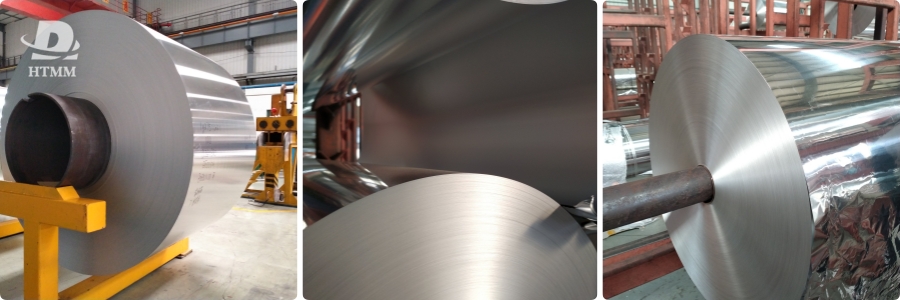Amidst shifting customer demands and regulatory policies, the worldwide beverage packaging business is constantly challenged to offer more cost-effective, high-performing, and sustainable solutions. Because of its special material qualities, 1235 aluminum foil for food packaging have become an innovative material that helps brands balance these needs. Compared to conventional laminated films and polymers, its excellent barrier properties, recyclability, adaptability, and value proposition offer strong advantages. 
Let's examine in detail how the benefits of 1235 aluminum foil for food packaging to the beverage packaging industry include longer shelf life, less environmental impact, more chances for creative expression, and overall cost savings. Responsible packaging choices that support sustainability, product protection, and financial viability throughout supply chains are informed by an understanding of its scientific underpinnings.
Better Performance of the Barrier
For beverages that are prone to oxidation, carbonation loss, and microbiological contamination, maintaining product freshness through efficient barrier features is still essential. Experimental studies demonstrate that 1235 aluminum vs. 8079 aluminum is superior to standard plastic sheets at preventing components that cause deterioration.
Oxygen Barrier: Over time, oxidation reactions that degrade nutrition, colors, and tastes are facilitated by oxygen. Based on independent ASTM D3985 tests, the 1235 aluminum vs. 8079 aluminum has one of the lowest oxygen transmission rates in the world (0.0008cc/100in2/day), preventing penetration beyond detection in as little as 24 hours.
On the other hand, the typical barrier level of widely used polyethylene terephthalate (PET) is 0.03cc, while laminated coatings take days to reach the same level. The pure aluminum layer formed by the tight crystalline structure of aluminum foil of alloy 1235 is only 0.0005" thick, but even the smallest oxygen molecules are prevented from entering the matrix. For the purpose of maximizing this priceless shelf life extension feature, no additional polymers or additives are required.
Barrier to Carbon Dioxide
Escaped CO2 causes carbonated drinks to lose their fizz, which degrades the drinking experience. Experiments reveal that the CO2 barrier of aluminum foil of alloy 1235 operates 300% better than that of multilayer plastic pouches, maintaining integrity for three times as long via less permeable aluminum channels. The fresh appeal is maintained by this preservation of taste and bubbles.
Barrier against Moisture
Safety is put at risk by moisture's promotion of microbial growth. According to independent research, 1235 O aluminum foil transmits just 0.013 grams of water vapor per square meter per day—about the same as rigid containers. Through tiny aluminum channels, 1235 O aluminum foil lowers damp conditions to less than 20% of rivals' rates when compared to top alternative laminate films that average 0.1g.
While minimizing protective chemicals like preservatives and optimizing packed headspace, optimal moisture control reduces the danger of contamination. Without extra layers or gas-scavenging materials, 1235 foil's absolute barrier capabilities prove its premium performance for the best possible product protection.
Superior Recyclability: Purchasing publics and regulators are placing increasing pressure on brands to decrease post-consumer waste and actively reuse materials when possible. Thankfully, 1235 aluminum foil makes exceptional circularity possible with closed-loop recycling technologies that are now widespread worldwide.
Following consumer usage, 1235 foil in laminated, rigid, or flexible formats can be sorted, collected in dual streams, or returned to retailers through take-back programs. Even after several remelting cycles, pure aluminum may be remelted with only 5% of the energy used for first extraction and without deteriorating. Depending on the location, current industry averages recover 75–95% of foil quantities after use.
However, because multilayer plastic films are so commonly used, they typically have complex sorting requirements that surpass processing capabilities or costs, making them some of the least recycled packaging. The EPA reports that even with collection, global plastic recycling rates average only 30% because of contamination problems. 1235 aluminum foil is unique in that it offers a genuinely circular solution that meets the strictest sustainability and recycling standards thanks to its superior material circularity, which has been verified by science.
Advanced Printing Features
Regulatory compliance, shelf distinctiveness, and informative labels are all aided by vibrant graphics and branding. Extensive research shows that 1235 aluminum foil is much more printable than paper and plastic film substitutes.
Its non-porous, atomically smooth surface, created by sophisticated cold rolling, consistently accepts a variety of solvent-based, water-based, UV, and heat transfer inks without exhibiting inconsistent absorption. To rival hard containers, the foil's highly shiny backdrop layer is transferred onto fine ink layers for maximum definition and impact.
Furthermore, 1235 foil offers possibilities for unique foil blocking, laminating, metallic, and embossed effects that are not achievable with conventional flexible substrates. Its responsiveness makes everything possible, from simple barcodes to complex changeable designs that enable creative ideas that harmonize packaging advances with corporate branding goals. Owners of brands understand how improved communication and creative freedom strengthen their products' shelf presence and legal safeguards.
Adaptable Formatting
Innovations in package shape that maximize production, distribution, store presence, and dispensing are still being pursued. With formable, heat formable, and cold formable inline processes that adapt to any container geometry—whether standing pouches, sleeve packs, cuboids, sachets, or aseptic cartons—1235 aluminum foil here exhibits unmatched flexibility.
When used in high-speed robotic applications that call for partial foil coverage, its memory consistently holds onto shapes. When complete enclosure is required, 1235 foil uses advanced heat sealing without weak spots to accurately adhere to even complex features, such as barrier-coated gable tops or three-piece cans.
Furthermore, 1235 does not lose its barrier integrity or develop stretch marks when sterilized under aseptic fill line circumstances. Its lubricious surface makes clean product removal easier, which is beneficial for thick formulas, liquids, and powders. These built-in formatting features reduce material requirements and streamline procedures.
Optimization of Total Cost
Though decisions are influenced by early expenditures, long-term total cost of ownership that takes into account material, processing, and end-of-life influences yields the true performance value. Out of all the options, 1235 aluminum foil makes the strongest economic argument.
Compared to alternative solutions, its exceptional barrier performance requires less aluminum material to satisfy standards. Compared to rigid containers or multilayer films, which require expensive blown film, lamination, or extrusion equipment in addition to raw polymers, processing costs are reduced. 
Furthermore, by using reverse logistics systems to save material spending, 1235 foil achieves internal scrap recycling rates of 85–95%. In contrast to burning plastics, remelting also recovers a significant amount of energy. Overall, downgauging opportunities and 1235's sustainable features significantly reduce per-unit costs, which benefits both brand budgets and environmental stewardship objectives.
The advantages of 1235 aluminum foil have been scientifically demonstrated, and it effectively meets the demands of contemporary beverage packaging in terms of performance, sustainability, and affordability—factors that will only grow stronger with time. Only the inherent aluminum densities, resulting from its purity, maximize shelf life and offer unparalleled barrier qualities that far outperform competitors. 
Furthermore, 1235 contributes to the environmental goals of the business by employing well-established reverse logistics infrastructures to achieve an exceptional average recycling rate of 75%. Its adaptable layout makes any application possible, and its extensive printability strengthens relationships with customers. All things considered, 1235 aluminum foil proves to be a very cost-effective solution that might be widely used to support industrial advancement in an ethical manner by using circular material thinking.

